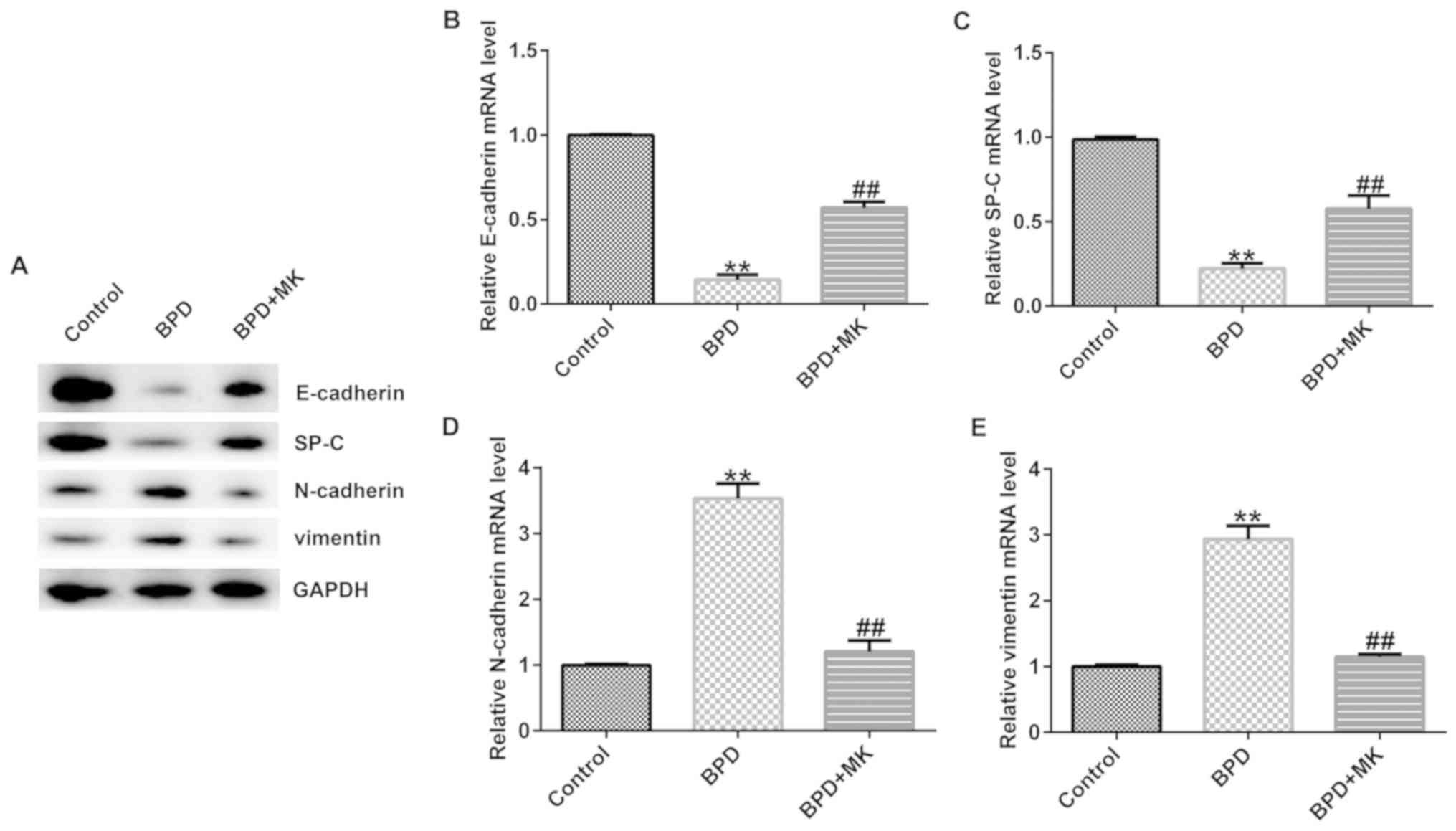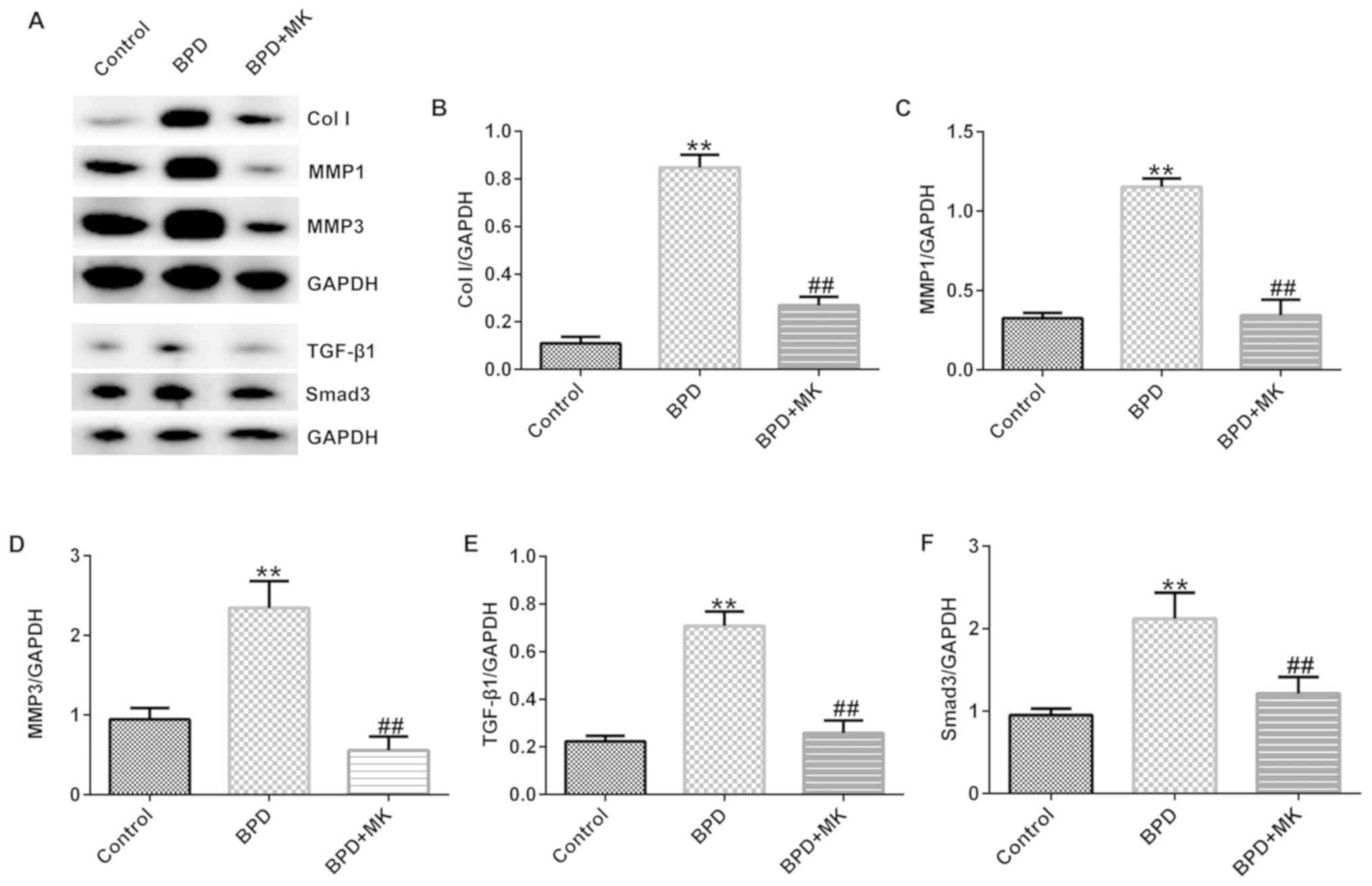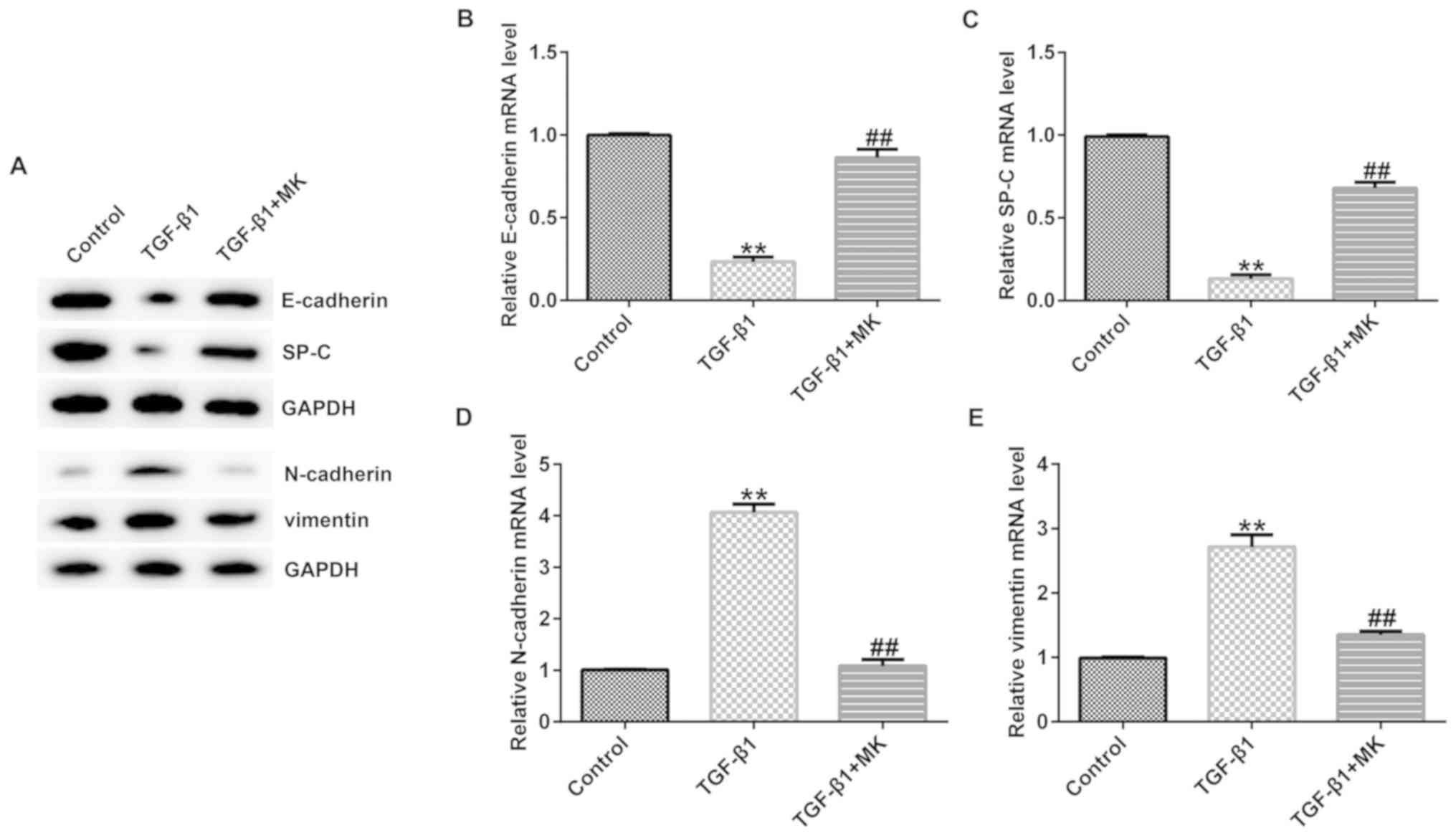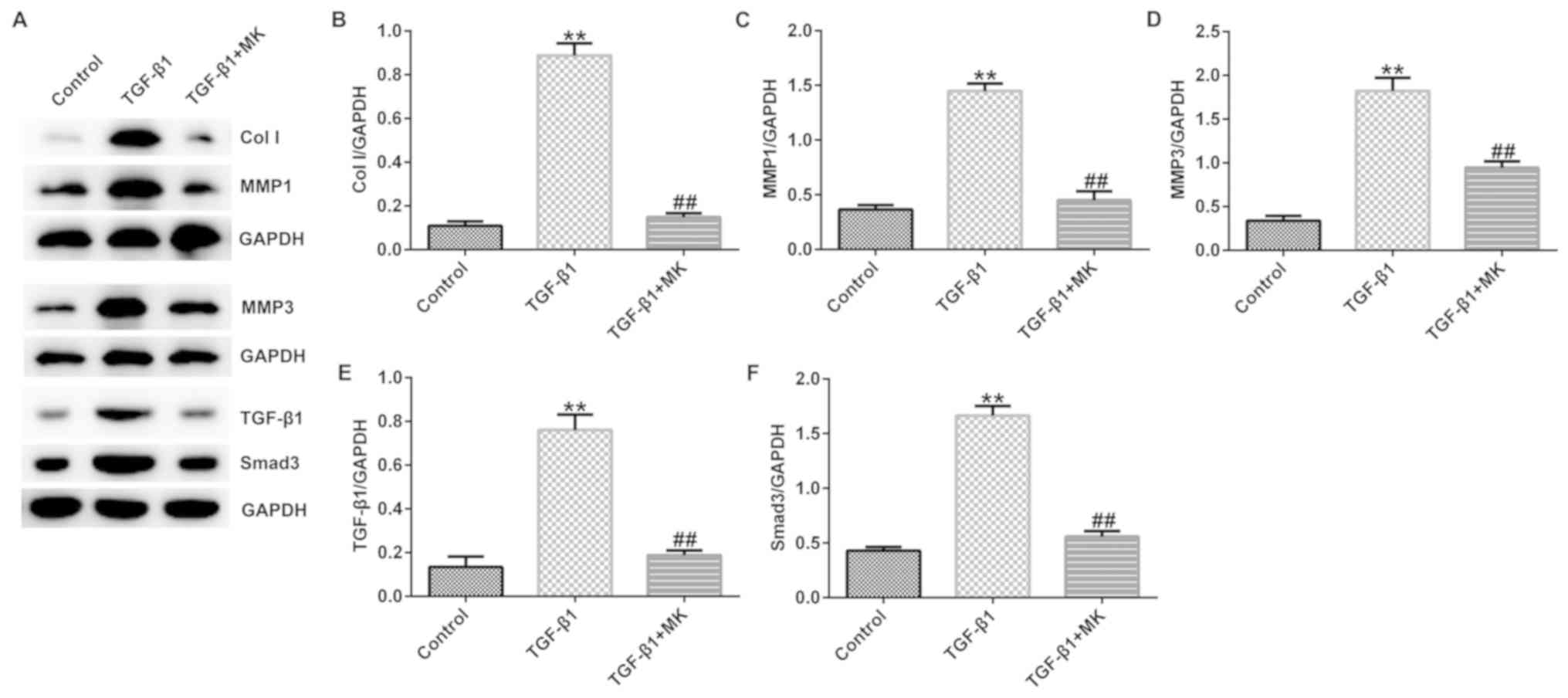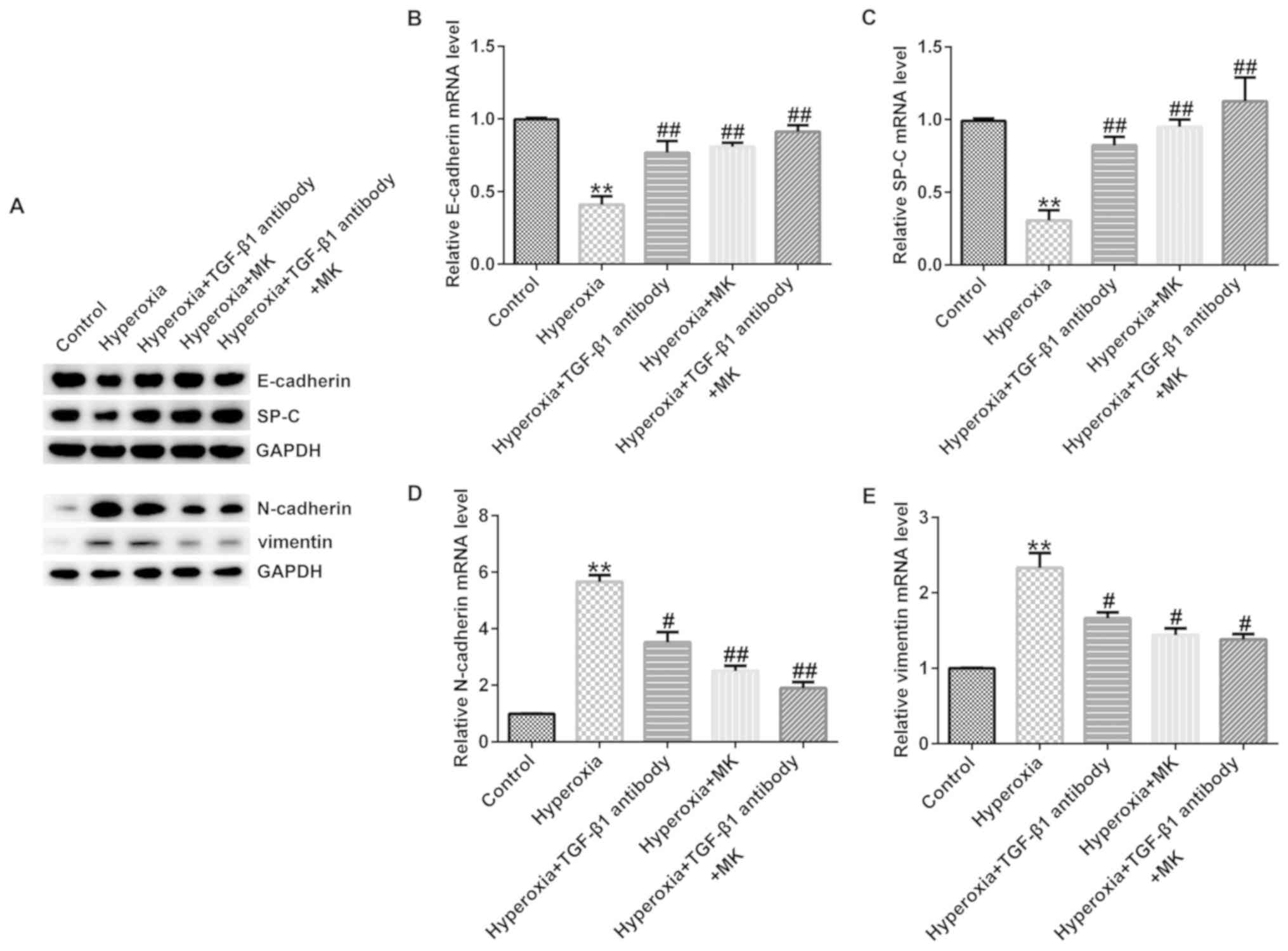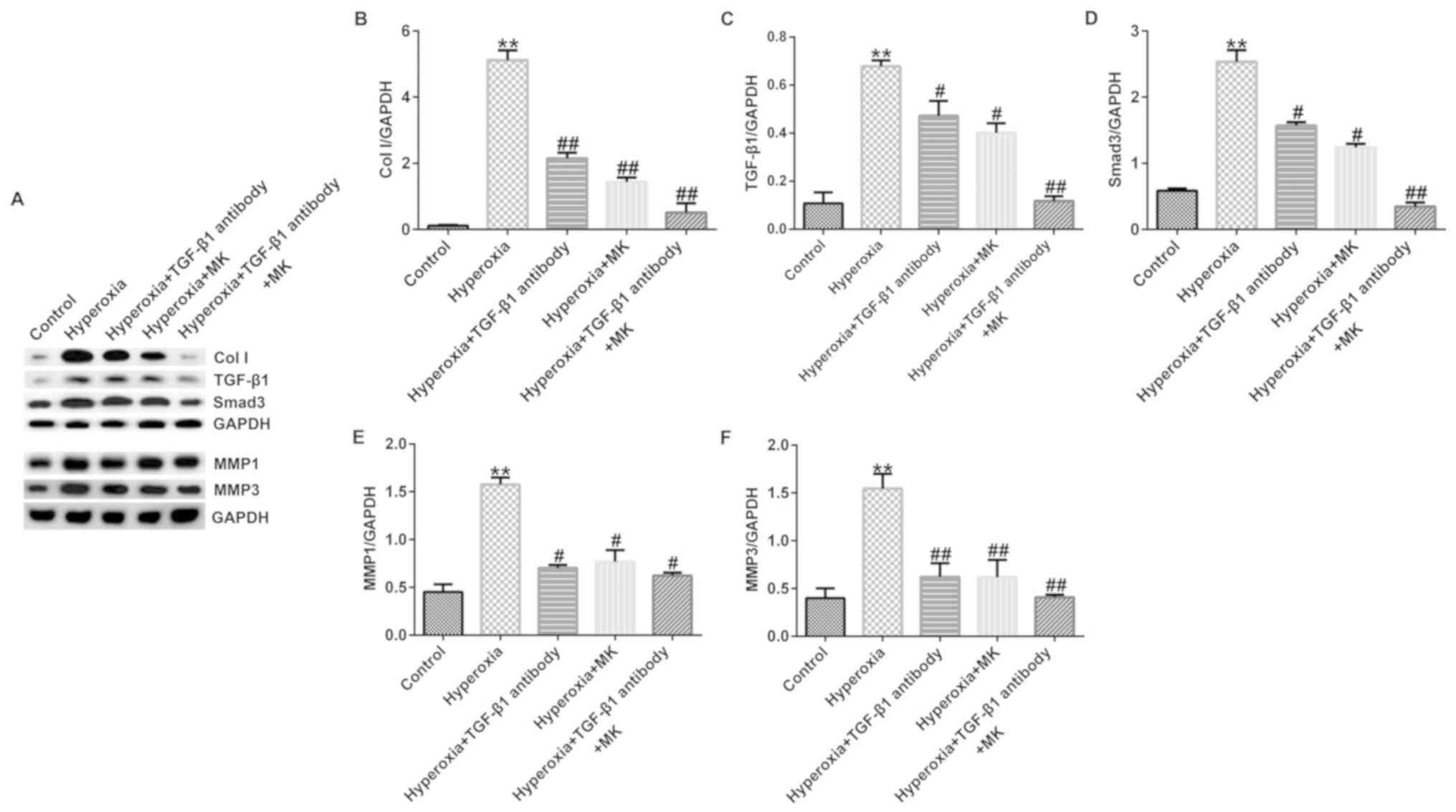Introduction
Bronchopulmonary dysplasia (BPD) is a common chronic
respiratory disease in preterm infants. Among preterm infants with
a gestational age <28 weeks, the incidence of BPD is ≥50% and
the mortality rate is ~64%. In addition, the readmission rate of
surviving preterm infants in the first year is >50% and the
occurrence of neurological dysplasia is 2–3 times higher compared
with normal infants (1–3). Clinically, classical BPD primarily
manifests as oxygen therapy dependence, which can result in
pulmonary infection, pulmonary hypertension, heart failure and
other complications (4–6). BPD has become a major disease that is
responsible for death and poor prognosis in premature infants,
seriously affecting their long-term quality of life. BPD is
harmful, but there is no effective treatment strategy at present.
It has been hypothesized that glucocorticoids display a certain
therapeutic effect on BPD (7);
however, based on the existing clinical evidence, the optimal
dosage scheme cannot be obtained. Moreover, glucocorticoids are
associated with serious adverse reactions, including inhibition of
the development of the nervous system and an increased incidence of
cerebral palsy (8,9). Therefore, identifying a novel, safe
and more effective BPD treatment strategy is important.
Montelukast (MK) is a common leukotriene receptor
antagonist with anti-inflammatory and antifibrosis effects, which
is typically used for asthma, allergic rhinitis and other
respiratory diseases (10).
Recently, a number of studies have reported that MK also displays a
protective effect in rheumatoid arthritis, ischemia reperfusion
injury and Parkinson's disease (11–13).
Additionally, it has been reported that increased leukotriene
levels are associated with BPD. Rupprech et al (14) treated preterm infants with BPD with
MK, and the results indicated that MK significantly improved the
survival rate of children with advanced severe BPD and reduced the
duration of mechanical ventilation, indicating improved efficacy
and a reduced risk of adverse reactions (15). However, Hou et al (16) demonstrated that compared with the
normoxic control group, hyperoxia significantly increased the level
of cysteinyl leukotrienes in bronchoalveolar lavage fluid of
newborn rats, and MK treatment did not improve the inhibition of
hyperoxia-induced alveolarization. Therefore, further investigation
into the mechanism underlying the effects of MK during BPD is
required.
Numerous signaling pathways that are crucial to lung
development have been studied, including the transforming growth
factor (TGF)-β signaling pathway (17,18).
TGF-β signaling can negatively regulate the branch and interval of
lung development, and has been demonstrated to be essential for
normal lung development through the regulation of endothelial cell
(EC) differentiation, growth, migration, senescence, and
extracellular matrix (ECM) production (19,20).
TGF-βs consist of three proteins, TGF-β 1, 2, and 3, and TGF-β1
activates the Smad pathway and non-Smad pathways such as
mitogen-activated protein kinase, phosphoinositide 3-kinases-AKT,
Rho, and downregulates peroxisome proliferator-activated receptor γ
expression through the Smad pathway (21). In alveolar epithelial cells (AEC),
TGF-β1 mediates epithelial-mesenchymal transition (EMT) leading to
lung fibrosis (22). Previous
studies have demonstrated that MK has a certain regulatory effect
on TGF-β signaling pathway in various diseases such as asthma and
pulmonary fibrosis (23–25). However, the effect of MK on TGF-β
signaling pathway in in BPD remains largely unclear.
The present study investigated whether MK displayed
an important role during BPD by regulating EMT, and further
analyzed the molecular mechanism underlying its effects, with the
aim of providing a theoretical basis for the use of MK as a
therapeutic strategy for BPD.
Materials and methods
Establishment of the rat model of
BPD
A total of ten pregnant Wistar rats (weight, 200–250
g; 10 weeks old) were purchased from the Animal Center of Nanjing
Medical University. Animals were housed at 25±5°C, with 50%
humidity and 12 h light/dark cycles with ad libitum supply
of food and water. A rat model of BPD was established according to
a previous study (26). Briefly,
the 15 pups of the pregnant Wistar rats were randomly divided into
the following three groups (n=5): i) BPD model group; ii) BPD + MK
group and; iii) control group. The model group rats were maintained
in a sealed Plexiglass chamber with 85% oxygen for 14 days from the
date of birth. The oxygen concentration in the chamber was
continuously recorded using an analyzer with a strip-chart recorder
(Servomex). The control group rats were maintained in room air. All
animal procedures were performed according to the Institutional
Animal Care and Use of Laboratory Animals guidelines by the
National Institutes of Health. The present study was approved by
the Animal Ethics Committee of The First Affiliated Hospital of
Bengbu Medical College.
Treatment of the rat model of BPD
The BPD + MK group were administered with an
intraperitoneal injection of 10 mg/kg MK (Sigma-Aldrich; Merck
KGaA) every other day from day 2 to day 14 post-hyperoxia induction
(27). The control and BPD model
groups were administered with an intraperitoneal injection of the
same amount of saline (0.9% NaCl). All efforts were made to
alleviate the pain of the rats throughout the experiment. In
addition, all experiments were stopped when the rats lost >15%
of their body weight. The health and behavior of all rats were
monitored every 2 days, and no rats died prior to the end of the
experiment. Rats were anaesthetized by pentobarbital
intraperitoneal injection (40 mg/kg) and subsequently sacrificed
via cervical dislocation (rats without a heartbeat and not
breathing were confirmed as dead) at 14 days after hyperoxia
induction, for further experiments.
Lung sample collection and lung
histology
Tissue samples from the middle lobe of the right
lungs in the rats were aerated with PBS under a pressure of 18 cm
H2O. Subsequently, tissue samples were fixed in 4%
paraformaldehyde (Beyotime Institute of Biotechnology) at 4°C
overnight. The lung tissues were embedded in paraffin and cut into
4-µm thick sections, following which they were rehydrated using an
alcohol gradient (absolute ethanol for 5 min; 90% ethanol for 2
min; 80% ethanol for 2 min; 70% ethanol for 2 min; distilled water
for 2 min), and stained with hematoxylin and eosin at room
temperature for 10 min. The mean linear intercept (MLI), which
represents the average alveolar diameter, was measured under a
fluorescent microscope at ×200 magnification. The number of alveoli
transected by the line from the center of the most peripheral
bronchiole to the pleura, which is defined as the radial alveolar
count (RAC), was calculated to evaluate the stage of lung
development. In addition, the right upper lung lobes of the rats
were collected and weighed to determine the lung weight/body weight
(LW/BW) ratio.
Type II alveolar epithelial (AEC II)
cell isolation and culture
AEC II cells were isolated from three rat pups from
the control group within 24 h of birth (28). Briefly, the lungs of newborn rat
pups were collected and digested with 0.25% Trypsin-EDTA (Gibco;
Thermo Fisher Scientific, Inc.) at 37°C. Subsequently, the lungs
were digested with 0.1% collagenase I (Gibco; Thermo Fisher
Scientific, Inc.) and filtered through a cell strainer (70 µm). The
isolated cells were resuspended and purified by centrifugation
(1,000 × g, 4°C, 5 min). Cells were incubated in minimum essential
medium (Gibco; Thermo Fisher Scientific, Inc.) containing 10% fetal
bovine serum (Gibco; Thermo Fisher Scientific, Inc.) at 37°C with
5% CO2. At passage 3, the purity and viability of AEC II
cells was determined according to a previous study (28,29),
and cells with 90% purity and >95% viability were used for
subsequent experiments.
Cells were randomly divided into the following two
groups: Hyperoxia-induced group (HOX group; cells cultured at 37°C
for 48 h in an 85% O2−5% CO2 incubator) and
the normoxic control group (NOX group; cells cultured at 37°C for
48 h in a 21% O2−5% CO2 incubator). The NOX
group was further divided into three subgroups: i) Control; ii)
transforming growth factor (TGF)-β1 (Sigma-Aldrich; Merck KGaA);
and iii) TGF-β1 + MK (10 µM). Cells in the TGF-β1 group were
cultured with TGF-β1 (3 ng/ml) at 37°C for 48 h to induce EMT.
Cells in the TGF-β1 + MK group were cultured with TGF-β1 (3 ng/ml)
at 37°C for 48 h to induce EMT and then treated with 10 µM MK at
37°C for 24 h. The HOX group was further divided into five
subgroups: i) Control; ii) hyperoxia; iii) hyperoxia + TGF-β1
antibody; iv) hyperoxia + MK; and v) hyperoxia + TGF-β1 antibody +
MK. Cells in the control group did not undergo any treatment.
Western blotting
The protein expression levels of surfactant protein
C (SP-C), E-cadherin, N-cadherin, Vimentin, collagen I (Col I),
matrix metallopeptidase (MMP)1/3, TGF-β1 and Smad3 in the tissue
samples and cells were determined by western blotting. Briefly,
total protein was extracted using a total protein extraction kit
(Beyotime Institute of Biotechnology), and quantified using the
Bicinchoninic Acid Protein kit (Pierce; Thermo Fisher Scientific,
Inc.). Proteins (40 µg per lane) were loaded on a 10% gel, resolved
via SDS-PAGE under reduced conditions, and subsequently transferred
to a PVDF membrane. The membrane was blocked with 5% non-fat milk
and PBS with 0.5% Tween-20 (PBST) solution at room temperature for
1 h. Subsequently, the membranes were incubated at 4°C overnight
with primary antibodies targeted against: SP-C (1:1,000; cat. no.
ab211326; Abcam), E-cadherin (1:1,000; cat. no. ab233766; Abcam),
N-cadherin (1:1,000; cat. no. ab76011; Abcam), Vimentin (1:1,000;
cat. no. ab137321; Abcam), Col I (1:1,000; cat. no. ab34710;
Abcam), MMP-1 (1:1,000; cat. no. ab137332; Abcam), MMP-3 (1:1,000;
cat. no. ab52915; Abcam), TGF-β1 (1:1,000; cat. no. ab92486;
Abcam), Smad3 (1:1,000; cat. no. ab40854; Abcam) and GAPDH
(1:1,000; cat. no. ab181602; Abcam). Following primary incubation,
the membrane was washed three times with PBST and incubated with a
horseradish peroxidase-conjugated secondary antibody (1:1,000; cat
no. ab7090; Abcam) for 1 h. Protein bands were visualized by
enhanced chemical luminescence (Beyotime Institute of
Biotechnology), according to the manufacturer's protocol. Protein
expression levels were semi-quantified using ImageJ software
version 1.46 (National Institutes of Health) with GAPDH as the
loading control.
RNA extraction and reverse
transcription-quantitative PCR (RT-qPCR)
Total RNA was isolated from the tissues and cells
using an RNA Isolation kit (Invitrogen; Thermo Fisher Scientific,
Inc.) according to the manufacturer's protocol, and reverse
transcribed into first strand cDNA using the cDNA Synthesis kit
(Invitrogen; Thermo Fisher Scientific, Inc.), according to the
manufacturer's protocol. The temperature protocol for the reverse
transcription reaction were as following: annealing at 25°C for 5
min, cDNA synthesis at 42°C for 60 min and termination at 80°C for
2 min. Subsequently, mRNA expression levels were assessed by qPCR
using a Prism 7000 Real-Time PCR system (Applied Biosystems; Thermo
Fisher Scientific, Inc.) with SYBR qPCR Master Mix (Vazyme Biotech
Co., Ltd.), according to the manufacturer's protocol. The primer
pairs used for qPCR were purchased from Sangon Biotech Co., Ltd.
The following primer sequences were used: SP-C forward,
5′-TTGGTCCTTCACCTCTGTCC-3′ and reverse, 5′-CTCCCACAATCACCACGAC-3′;
Vimentin forward, 5′-GACGCCATCAACACCGAGTT-3′ and reverse,
5′-CTTTGTCGTTGGTTAGCTGGT-3′; E-cadherin forward,
5′-CGAGAGCTACACGTTCACGG-3′ and reverse,
5′-GGGTGTCGAGGGAAAAATAGG-3′; N-cadherin forward,
5′-TTTGATGGAGGTCTCCTAACACC-3′ and reverse,
5′-ACGTTTAACACGTTGGAAATGTG-3′; GAPDH forward,
5′-CTTTGGTATCGTGGAAGGACTC-3′ and reverse,
5′-GTAGAGGCAGGGATGATGTTCT-3′. The following thermocycling
conditions were used for qPCR: 5 min at 95°C; followed by 40 cycles
of 95°C for 10 sec and 60°C for 30 sec. mRNA expression levels
(SP-C, E-cadherin, N-cadherin, Vimentin) were quantified using the
2−ΔΔCq method (30) and
normalized to the internal reference gene GAPDH.
Statistical analysis
Data are presented as the mean ± standard deviation
of at least three independent experiments. One-way ANOVA followed
by Tukey's post hoc test was used for comparisons between multiple
groups. Statistical analyses were performed using SPSS software
(version 18; SPSS, Inc.). P<0.05 was considered to indicate a
statistically significant difference.
Results
Effects of MK on alveolarization and
lung injury in a rat model of BPD
To assess the effects of MK on lung function, the
MLI, RAC and LW/BW ratio of the lungs were assessed in the
different groups. The MLI of the BPD model group was longer
compared with the control group, and MK treatment significantly
decreased the MLI in the BPD model group (Fig. 1A). Similarly, MK markedly
significantly the RAC and decreased the LW/BW ratio in the BPD
model group (Fig. 1B and C).
Effects of MK on EMT in a
hyperoxia-induced rat model of BPD
The lung tissues of the rats were isolated at day 14
post-hyperoxia induction, and the protein and mRNA expression
levels of epithelial cell markers E-cadherin and SP-C, as well as
mesenchymal cell markers N-cadherin and Vimentin, were measured by
western blotting and RT-qPCR, respectively. The protein expression
levels of E-cadherin and SP-C in the BPD model group were markedly
decreased, whereas the protein expression levels of N-cadherin and
Vimentin were increased compared with the control group (Fig. 2A). The mRNA expression levels of
E-cadherin and SP-C in the BPD model group were significantly
decreased, whereas the mRNA expression levels of N-cadherin and
Vimentin were significantly increased compared with the control
group (Fig. 2B-E). MK treatment
notably inhibited BPD-induced effects on protein and mRNA
expression levels (Fig. 2A-E).
Effects of MK on the TGF-β signaling
pathway in a hyperoxia-induced rat model of BPD
In addition, western blotting was performed to
measure the relative expression of TGF-β signaling pathway-related
proteins Col I, MMP1/3, TGF-β1 and Smad3. Compared with the control
group, the expression levels of Col I, MMP1 and MMP3 in the BPD
model group were significantly increased, and MK treatment
significantly inhibited these effects (Fig. 3A-D). Similarly, the expression
levels of TGF-β1 and Smad3 in the BPD model group were increased
compared with the control group, which were significantly decreased
by treatment with MK (Fig. 3A, E and
F).
Effects of MK on TGF-β1-induced EMT in
AEC II cells derived from normal rats
AEC II cells were isolated from the normal rats and
incubated with TGF-β1 to induce EMT. The protein and mRNA
expression levels of E-cadherin, SP-C, N-cadherin and Vimentin were
measured by western blotting and RT-qPCR. Compared with the control
group, the protein expression levels of E-cadherin and SP-C in the
TGF-β1 group were markedly decreased, whereas the protein
expression levels of N-cadherin and Vimentin were notably
increased, and these alterations were inhibited by treatment with
MK (Fig. 4A). Compared with the
control group, the mRNA expression levels of E-cadherin and SP-C in
the TGF-β1 group were significantly decreased, whereas the mRNA
expression levels of N-cadherin and Vimentin were significantly
increased, and these alterations were inhibited by treatment with
MK (Fig. 4B-E).
Effects of MK on the TGF-β signaling
pathway in AEC II cells derived from normal rats
Furthermore, western blotting was performed to
detect the protein expression levels of TGF-β signal
pathway-related proteins Col I, MMP1/3, TGF-β1 and Smad3. The
results indicated that the expression levels of Col I, MMP1 and
MMP3 in the TGF-β1 group were significantly increased compared with
the control group, which were significantly decreased by MK
treatment (Fig. 5A-D). The
expression levels of TGF-β1 and Smad3 in the TGF-β1 group were also
increased compared with the control group, which were significantly
decreased by treatment with MK (Fig.
5A, E and F).
Effects of MK on EMT in
hyperoxia-induced AEC II cells
To further explore the effect of MK on EMT in AEC II
cells derived from a hyperoxia-induced rat model of BPD, the
effects of MK on hyperoxia-induced AEC II cells were investigated.
AEC II cells were divided into five groups (hyperoxia group,
hyperoxia + TGF-β1 antibody group, hyperoxia + MK group, hyperoxia
+ TGF-β1 antibody + MK group, and control group), and the protein
and mRNA expression levels of E-cadherin, SP-C, N-cadherin and
Vimentin were detected by western blotting and RT-qPCR,
respectively. The results suggested that, compared with the control
group, the protein expression levels of E-cadherin and SP-C in the
hyperoxia group were reduced, and the protein expression levels of
N-cadherin and Vimentin were notably increased (Fig. 6A). Compared with the control group,
the mRNA expression levels of E-cadherin and SP-C in the hyperoxia
group were significantly reduced, and the mRNA expression levels of
N-cadherin and Vimentin were significantly increased (Fig. 6B-E). Furthermore, hyperoxia-induced
alterations to protein and mRNA expression were inhibited by
treatment with MK or TGF-β1 antibody, with the TGF-β1 antibody + MK
group displaying the most effective inhibition (Fig. 6A-E).
Effects of MK on the TGF-β signaling
pathway in hyperoxia-induced AEC II cells
The hyperoxia group displayed a significant increase
in the expression levels of Col I, MMP1 and MMP3 compared with the
control group, which was notably inhibited by treatment with MK or
TGF-β1 antibody. The combined treatment of MK and TGF-β1 was more
effective compared with either treatment alone (Fig. 7A, B and F). Furthermore, compared
with the control group, the expression levels of TGF-β1 and Smad3
in the hyperoxia group were markedly increased, and
hyperoxia-induced effects were suppressed by treatment with MK or
TGF-β1 (Fig. 7A, C and D).
Discussion
BPD is caused by immature lung development in
premature infants, resulting in a cascade secondary inflammatory
response induced by high oxygen injury, volume injury, barotrauma,
infection and open arterial catheters (31,32).
A large number of inflammatory cells infiltrate the lungs and
release a high number of inflammatory mediators, which lead to
further lung injury, and eventually result in pulmonary fibrosis
and BPD (33,34). Therefore, the current treatment
strategies for BPD primarily focus on reducing the secondary
inflammatory response and lung injury induced by abnormal
repair.
There have been several related studies on the
effect of MK on BPD (14,15,27).
Besides, Kim et al (35)
have reported the efficacy and safety of MK sodium in the
prevention of bronchopulmonary dysplasia. However, the effect and
mechanism of MK on BPD still need to be further explored. In the
present study, a hyperoxia-induced rat model of BPD was established
to investigate the effects of MK during BPD. Rats were treated with
10 mg/kg MK and lung function was evaluated at day 14
post-hyperoxia induction. The MK group displayed a significantly
lower MLI and LW/BW ratio, and an increased RAC compared with the
control group, suggesting that MK displayed a protective effect
against lung injury in the rat model of BPD. However, this study
did not include the histology data, which is a limitation of the
present study.
Abnormal repair and pulmonary fibrosis following
acute lung injury leads to BPD, EMT results in pulmonary fibrosis,
disease progression and deterioration of BPD (36). Previous studies have reported that
the TGF-β signaling pathway is aberrantly activated during the
progression of EMT (37,38); therefore, it was hypothesized that
MK may improve BPD by inhibiting the process of EMT. Western
blotting and RT-qPCR were performed to detect alterations to the
expression levels of EMT- and TGF-β signaling pathway-related
genes. The results indicated that MK upregulated the expression
levels of the epithelial-related genes SP-C and E-cadherin, and
downregulated the expression levels of the interstitial-related
genes Vimentin and N-cadherin in the lung tissues. In addition, MK
decreased the expression of Col I, MMP, MMP3, TGF-β1 and Smad3. The
results indicated that MK inhibited the process of EMT and the
TGF-β signaling pathway in the hyperoxia-induced rat model of
BPD.
AEC II cells are pulmonary epithelial progenitor
cells, and AEC II cell injury is an important mechanism underlying
BPD-related pulmonary epithelial injury (39). In the present study, AEC II cells
were isolated from the lungs of normal rats and the rat model of
BPD, and subsequently, the effects of MK on EMT and the TGF-β
signaling pathway in AEC II cells were investigated. Similarly, the
results indicated that MK inhibited the process of EMT and the
TGF-β signaling pathway in AEC II cells.
In conclusion, the results suggested that MK
improved BPD by mediating EMT in AEC II cells via inhibiting the
TGF-β1/Smads signaling pathway. The present study suggested that MK
displayed protective effects against BPD, which indicated that MK
might serve as a potential therapeutic agent for BPD.
Acknowledgements
Not applicable.
Funding
The present study was supported by the Key Project
of Natural Science of Colleges and Universities in Anhui Province
(grant no. KJ2019A0378).
Availability of data and materials
All datasets used and/or analyzed during the current
study are available from the corresponding author on reasonable
request.
Authors' contributions
XC and WP contributed to study design, data
collection, statistical analysis, data interpretation and
manuscript preparation. ZZ contributed to data collection and
statistical analysis. RZ and JX contributed to data collection,
statistical analysis and manuscript preparation. All authors read
and approved the final manuscript.
Ethics approval and consent to
participate
All animal procedures were performed according to
the Institutional Animal Care and Use of Laboratory Animals
guidelines by the National Institutes of Health. The present study
was approved by the Animal Ethics Committee of The First Affiliated
Hospital of Bengbu Medical College.
Patient consent for publication
Not applicable.
Competing interests
The authors declare that they have no competing
interests.
References
|
1
|
Islam JY, Keller RL, Aschner JL, Hartert
TV and Moore PE: Understanding the Short- and Long-Term Respiratory
Outcomes of Prematurity and Bronchopulmonary Dysplasia. Am J Respir
Crit Care Med. 192:134–156. 2015. View Article : Google Scholar : PubMed/NCBI
|
|
2
|
Owen LS, Manley BJ, Davis PG and Doyle LW:
The evolution of modern respiratory care for preterm infants.
Lancet. 389:1649–1659. 2017. View Article : Google Scholar : PubMed/NCBI
|
|
3
|
Principi N, Di Pietro GM and Esposito S:
Bronchopulmonary dysplasia: Clinical aspects and preventive and
therapeutic strategies. J Transl Med. 16:36–48. 2018. View Article : Google Scholar : PubMed/NCBI
|
|
4
|
Metcalfe A, Lisonkova S, Sabr Y, Stritzke
A and Joseph KS: Neonatal respiratory morbidity following exposure
to chorioamnionitis. BMC Pediatr. 17:1282017. View Article : Google Scholar : PubMed/NCBI
|
|
5
|
Rutkowska M, Hożejowski R, Helwich E,
Borszewska-Kornacka MK and Gadzinowski J: Severe bronchopulmonary
dysplasia incidence and predictive factors in a prospective,
multicenter study in very preterm infants with respiratory distress
syndrome. J Matern Fetal Neonatal Med. 32:1958–1964. 2019.
View Article : Google Scholar : PubMed/NCBI
|
|
6
|
Krishnan U, Feinstein JA, Adatia I, Austin
ED, Mullen MP, Hopper RK, Hanna B, Romer L, Keller RL, Fineman J,
et al Pediatric pulmonary hypertension network (PPHNet), :
Evaluation and management of pulmonary hypertension in children
with bronchopulmonary dysplasia. J Pediatr. 188:24–34.e1. 2017.
View Article : Google Scholar : PubMed/NCBI
|
|
7
|
Bassler D, Plavka R, Shinwell ES, Hallman
M, Jarreau PH, Carnielli V, Van den Anker JN, Meisner C, Engel C,
Schwab M, et al NEUROSIS Trial Group, : Early Inhaled Budesonide
for the Prevention of Bronchopulmonary Dysplasia. N Engl J Med.
373:1497–1506. 2015. View Article : Google Scholar : PubMed/NCBI
|
|
8
|
Onland W, De Jaegere AP, Offringa M and
van Kaam A: Systemic corticosteroid regimens for prevention of
bronchopulmonary dysplasia in preterm infants. Cochrane Database
Syst Rev. 1:CD0109412017.PubMed/NCBI
|
|
9
|
Halliday HL: Update on Postnatal Steroids.
Neonatology. 111:415–422. 2017. View Article : Google Scholar : PubMed/NCBI
|
|
10
|
Barbosa JS, Almeida Paz FA and Braga SS:
Montelukast medicines of today and tomorrow: From molecular
pharmaceutics to technological formulations. Drug Deliv.
23:3257–3265. 2016. View Article : Google Scholar : PubMed/NCBI
|
|
11
|
Dong H, Liu F, Ma F, Xu L, Pang L, Li X,
Liu B and Wang L: Montelukast inhibits inflammatory response in
rheumatoid arthritis fibroblast-like synoviocytes. Int
Immunopharmacol. 61:215–221. 2018. View Article : Google Scholar : PubMed/NCBI
|
|
12
|
Bilgiç Mİ, Altun G, Çakıcı H, Gideroğlu K
and Saka G: The protective effect of Montelukast against skeletal
muscle ischemia reperfusion injury: An experimental rat model. Ulus
Travma Acil Cerrahi Derg. 24:185–190. 2018.PubMed/NCBI
|
|
13
|
Nagarajan VB and Marathe PA: Effect of
montelukast in experimental model of Parkinson's disease. Neurosci
Lett. 682:100–105. 2018. View Article : Google Scholar : PubMed/NCBI
|
|
14
|
Rupprecht T, Rupprecht C, Harms D,
Sterlacci W, Vieth M and Seybold K: Leukotriene receptor blockade
as a life-saving treatment in severe bronchopulmonary dysplasia.
Respiration. 88:285–290. 2014. View Article : Google Scholar : PubMed/NCBI
|
|
15
|
Jouvencel P, Fayon M, Choukroun ML, Carles
D, Montaudon D, Dumas E, Begueret H and Marthan R: Montelukast does
not protect against hyperoxia-induced inhibition of alveolarization
in newborn rats. Pediatr Pulmonol. 35:446–451. 2003. View Article : Google Scholar : PubMed/NCBI
|
|
16
|
Hou A, Fu J, Yang H, Zhu Y, Pan Y, Xu S
and Xue X: Hyperoxia stimulates the transdifferentiation of type II
alveolar epithelial cells in newborn rats. Am J Physiol Lung Cell
Mol Physiol. 308:L861–L872. 2015. View Article : Google Scholar : PubMed/NCBI
|
|
17
|
Stenmark KR and Abman SH: Lung vascular
development: Implications for the pathogenesis of bronchopulmonary
dysplasia. Annu Rev Physiol. 67:623–661. 2005. View Article : Google Scholar : PubMed/NCBI
|
|
18
|
Dasgupta C, Sakurai R, Wang Y, Guo P,
Ambalavanan N, Torday JS and Rehan VK: Hyperoxia-induced neonatal
rat lung injury involves activation of TGF-β and Wnt signaling and
is protected by rosiglitazone. Am J Physiol Lung Cell Mol Physiol.
296:L1031–L1041. 2009. View Article : Google Scholar : PubMed/NCBI
|
|
19
|
Roth-Kleiner M and Post M: Similarities
and dissimilarities of branching and septation during lung
development. Pediatr Pulmonol. 40:113–134. 2005. View Article : Google Scholar : PubMed/NCBI
|
|
20
|
Upton PD and Morrell NW: The transforming
growth factor-β-bone morphogenetic protein type signalling pathway
in pulmonary vascular homeostasis and disease. Exp Physiol.
98:1262–1266. 2013. View Article : Google Scholar : PubMed/NCBI
|
|
21
|
Fu M, Zhang J, Lin Y, Zhu X, Zhao L, Ahmad
M, Ehrengruber MU and Chen YE: Early stimulation and late
inhibition of peroxisome proliferator-activated receptor gamma
(PPAR gamma) gene expression by transforming growth factor beta in
human aortic smooth muscle cells: Role of early growth-response
factor-1 (Egr-1), activator protein 1 (AP1) and Smads. Biochem J.
370:1019–1025. 2003. View Article : Google Scholar : PubMed/NCBI
|
|
22
|
Willis BC, Liebler JM, Luby-Phelps K,
Nicholson AG, Crandall ED, du Bois RM and Borok Z: Induction of
epithelial-mesenchymal transition in alveolar epithelial cells by
transforming growth factor-beta1: Potential role in idiopathic
pulmonary fibrosis. Am J Pathol. 166:1321–1332. 2005. View Article : Google Scholar : PubMed/NCBI
|
|
23
|
Liao JY and Zhang T: Effects of
montelukast sodium and bacterial lysates on airway remodeling and
expression of transforming growth factor-β1 and Smad7 in guinea
pigs with bronchial asthma. Zhongguo Dang Dai Er Ke Za Zhi.
20:1063–1069. 2018.(In Chinese). PubMed/NCBI
|
|
24
|
Hosoki K, Kainuma K, Toda M, Harada E,
Chelakkot-Govindalayathila AL, Roeen Z, Nagao M,
D'Alessandro-Gabazza CN, Fujisawa T and Gabazza EC: Montelukast
suppresses epithelial to mesenchymal transition of bronchial
epithelial cells induced by eosinophils. Biochem Biophys Res
Commun. 449:351–356. 2014. View Article : Google Scholar : PubMed/NCBI
|
|
25
|
Shimbori C, Shiota N and Okunishi H:
Effects of montelukast, a cysteinyl-leukotriene type 1 receptor
antagonist, on the pathogenesis of bleomycin-induced pulmonary
fibrosis in mice. Eur J Pharmacol. 650:424–430. 2011. View Article : Google Scholar : PubMed/NCBI
|
|
26
|
Sun H, Choo-Wing R, Fan J, Leng L, Syed
MA, Hare AA, Jorgensen WL, Bucala R and Bhandari V: Small molecular
modulation of macrophage migration inhibitory factor in the
hyperoxia-induced mouse model of bronchopulmonary dysplasia. Respir
Res. 14:272013. View Article : Google Scholar : PubMed/NCBI
|
|
27
|
Chen X, Zhang X and Pan J: Effect of
Montelukast on Bronchopulmonary Dysplasia (BPD) and Related
Mechanisms. Med Sci Monit. 25:1886–1893. 2019. View Article : Google Scholar : PubMed/NCBI
|
|
28
|
Ji W, Fu J, Nie H and Xue X: Expression
and activity of epithelial sodium channel in hyperoxia-induced
bronchopulmonary dysplasia in neonatal rats. Pediatr Int.
54:735–742. 2012. View Article : Google Scholar : PubMed/NCBI
|
|
29
|
Chen J, Chen Z, Narasaraju T, Jin N and
Liu L: Isolation of highly pure alveolar epithelial type I and type
II cells from rat lungs. Lab Invest. 84:727–735. 2004. View Article : Google Scholar : PubMed/NCBI
|
|
30
|
Livak KJ and Schmittgen TD: Analysis of
relative gene expression data using real-time quantitative PCR and
the 2(−ΔΔC(T)) method. Methods. 25:402–408. 2001. View Article : Google Scholar : PubMed/NCBI
|
|
31
|
Maturu P, Wei-Liang Y, Androutsopoulos VP,
Jiang W, Wang L, Tsatsakis AM and Couroucli XI: Quercetin
attenuates the hyperoxic lung injury in neonatal mice: Implications
for Bronchopulmonary dysplasia (BPD). Food Chem Toxicol. 114:23–33.
2018. View Article : Google Scholar : PubMed/NCBI
|
|
32
|
Hou A, Fu J, Yang H, Zhu Y, Pan Y, Xu S
and Xue X: Hyperoxia stimulates the transdifferentiation of type II
alveolar epithelial cells in newborn rats. Am J Physiol Lung C.
308:L861–L872. 2015. View Article : Google Scholar
|
|
33
|
Collins JJP, Tibboel D, de Kleer IM, Reiss
IKM and Rottier RJ: The future of bronchopulmonary dysplasia:
Emerging pathophysiological concepts and potential new avenues of
treatment. Front Med (Lausanne). 4:612017. View Article : Google Scholar : PubMed/NCBI
|
|
34
|
Niedermaier S and Hilgendorff A:
Bronchopulmonary dysplasia - an overview about pathophysiologic
concepts. Mol Cell Pediatr. 2:22015. View Article : Google Scholar : PubMed/NCBI
|
|
35
|
Kim SB, Lee JH, Lee J, Shin SH, Eun HS,
Lee SM, Sohn JA, Kim HS, Choi BM, Park MS, et al: The efficacy and
safety of Montelukast sodium in the prevention of bronchopulmonary
dysplasia. Korean J Pediatr. 58:347–353. 2015. View Article : Google Scholar : PubMed/NCBI
|
|
36
|
Bartis D, Mise N, Mahida RY, Eickelberg O
and Thickett DR: Epithelial-mesenchymal transition in lung
development and disease: Does it exist and is it important? Thorax.
69:760–765. 2014. View Article : Google Scholar : PubMed/NCBI
|
|
37
|
Tian M and Schiemann WP: TGF-β Stimulation
of EMT programs elicits non-genomic ER-α activity and anti-estrogen
resistance in breast cancer cells. J Cancer Metastasis Treat.
3:150–160. 2017. View Article : Google Scholar : PubMed/NCBI
|
|
38
|
Wang J, Bao L, Yu B, Liu Z, Han W, Deng C
and Guo C: Interleukin-1β promotes epithelial-derived alveolar
elastogenesis via αvβ6 integrin-dependent TGF-β activation. Cell
Physiol Biochem. 36:2198–2216. 2015. View Article : Google Scholar : PubMed/NCBI
|
|
39
|
Roper JM, Mazzatti DJ, Watkins RH,
Maniscalco WM, Keng PC and O'Reilly MA: In vivo exposure to
hyperoxia induces DNA damage in a population of alveolar type II
epithelial cells. Am J Physiol Lung C. 286:L1045–L1054. 2004.
View Article : Google Scholar
|
















